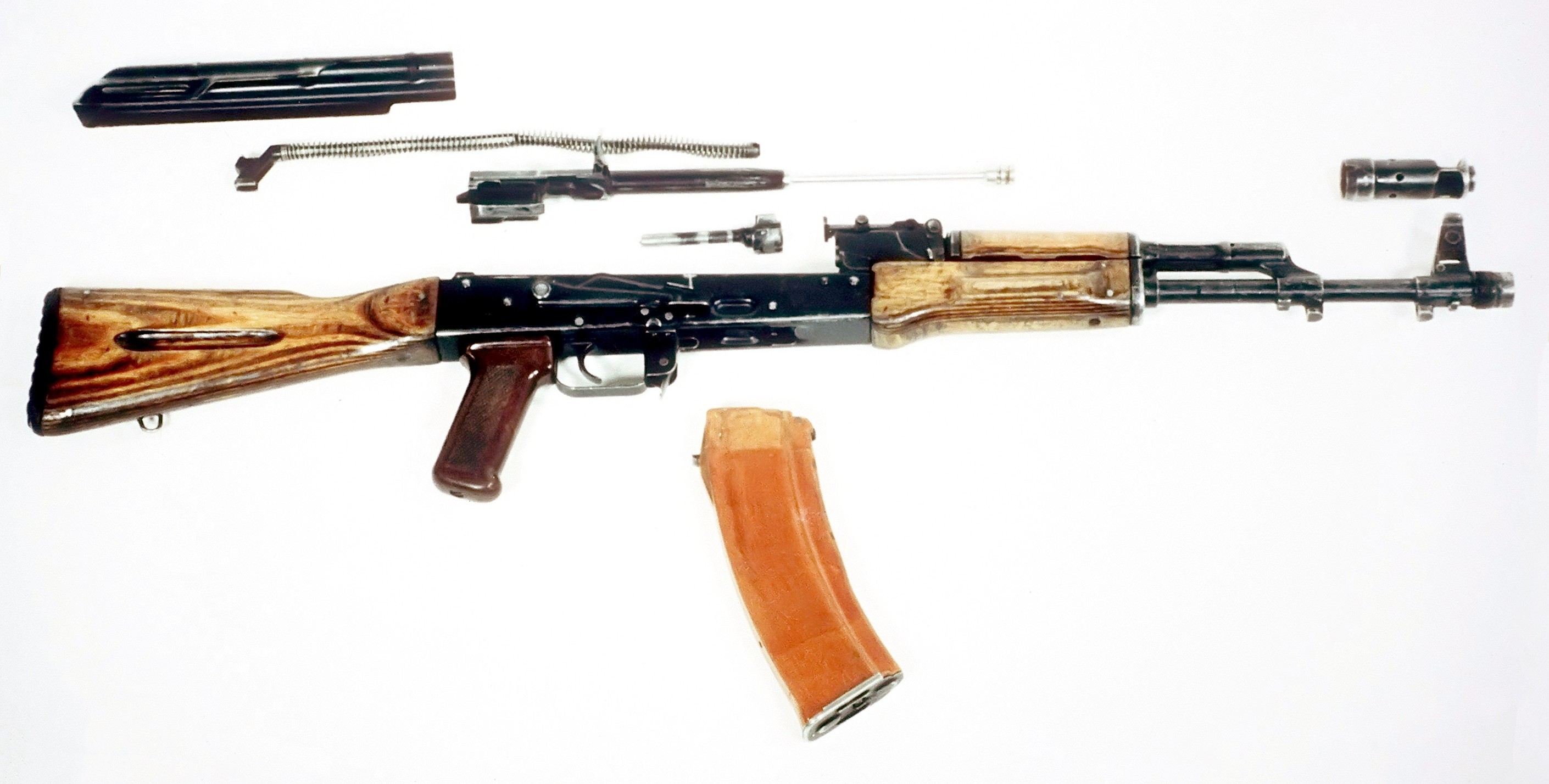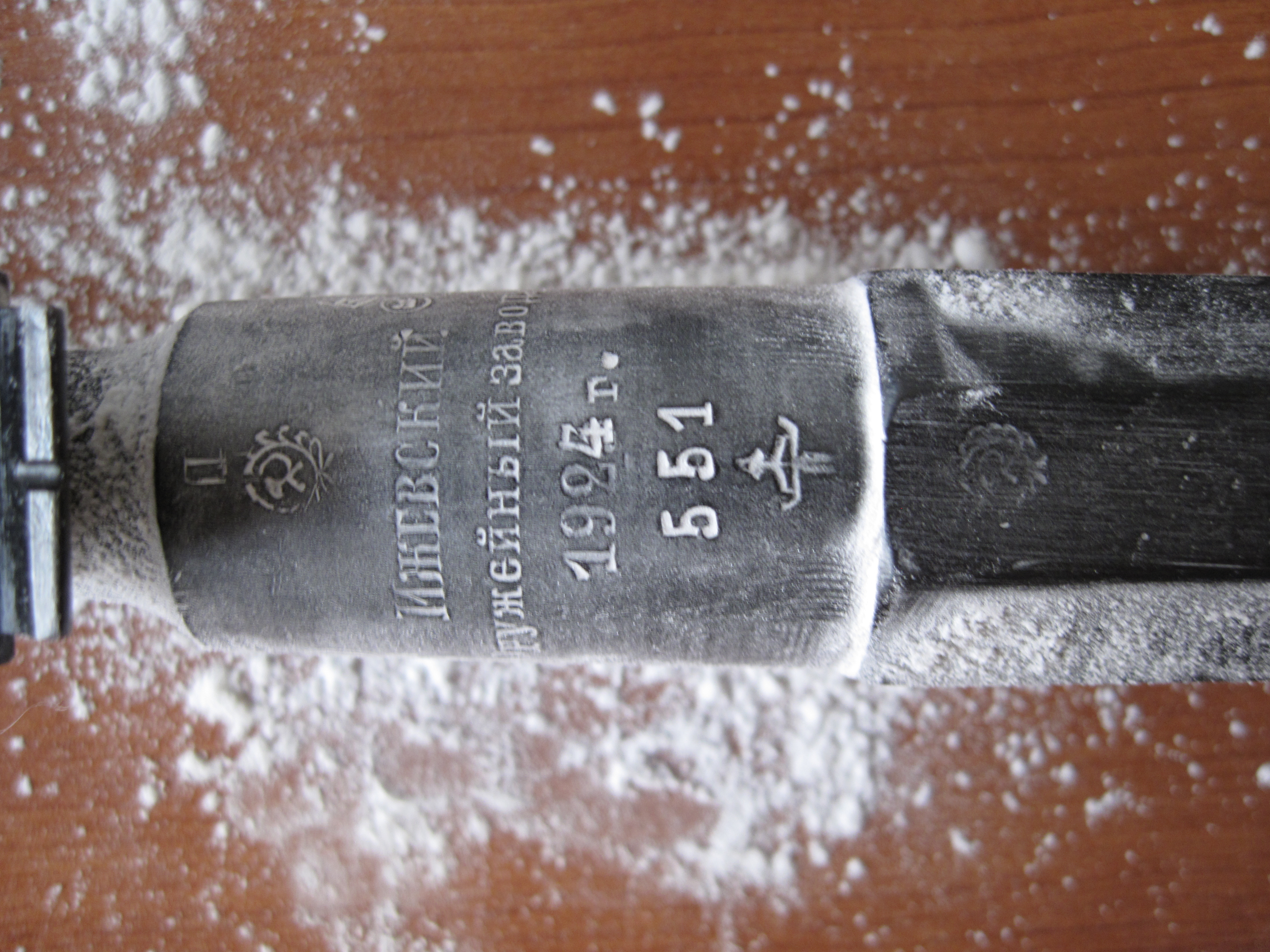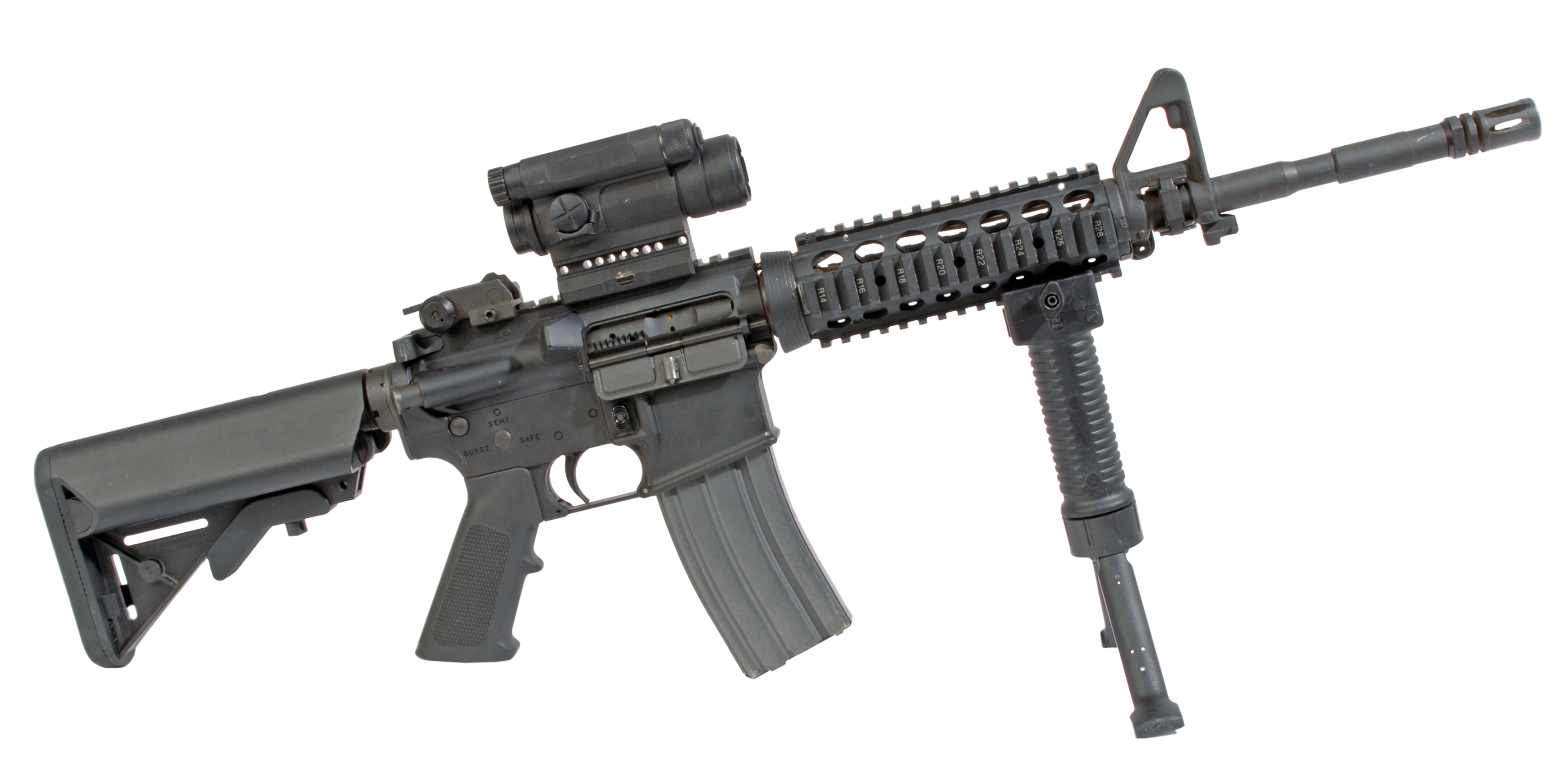|
AK-103
The AK-103 is a Russian assault rifle designed by small arms designer Mikhail Kalashnikov. History The AK-103 was officially offered for export in March 1993 Design details It is an AK-100 derivative of the AK-74M that is chambered for the 7.62x39mm M43 cartridge, similar to the AKM. The AK-103 can be fitted with a variety of sights, including night vision and telescopic sights, plus a knife-bayonet or a grenade launcher like the GP-34. Newer versions can fit Picatinny rails, allowing more accessories to be mounted. It uses plastic components where possible instead of wood or metal, with such components being the pistol grip, handguards, folding stock and depending on the type, the magazine. Protective coatings for corrosion resistance of metal parts. Forearm, magazine, butt stock and pistol grip are made of high strength shatterproof plastic. The AK-104 is a compact version of the AK-103. It has a muzzle brake derived from the older AKS-74U combined with a shorter barr ... [...More Info...] [...Related Items...] OR: [Wikipedia] [Google] [Baidu] |
AK-104
The AK-104 is a carbine variant of the AK-103. It's chambered to fire 7.62×39mm ammunition and thusly feeds from any standard 7.62x39 AK pattern magazine. Design The AK-104 is a 314mm (12.4in) barreled carbine in the AK-100 series of rifles, the dimensions of the gun is the same to other carbines of the AK-100 series. However, the AK-104 also features a solid, side-folding polymer stock, unlike the shorter, skeleton-stocked AKS-74U. The AK-104 uses an adjustable notched rear tangent iron sight calibrated in increments from . The front sight is a post adjustable for elevation in the field. Horizontal adjustment is done by the armory before issue. The AK-104 has a muzzle booster derived from the AKS-74U. Protective coatings ensure excellent corrosion resistance of metal parts. Forearm, magazine, butt stock and pistol grip are made of high strength plastic. The 100-series AKs are produced by the Izhmash factories in Izhevsk, Russia. Variants AK-105 SLR-107CR A civilian semi ... [...More Info...] [...Related Items...] OR: [Wikipedia] [Google] [Baidu] |
AK-74
The AK-74 (Russian: , tr. ''Avtomat Kalashnikova obraztsa 1974 goda'', lit. 'Kalashnikov assault rifle model 1974) is an assault rifle designed by small arms designer Mikhail Kalashnikov in 1974. While primarily associated with the Soviet Union, it has been used by multiple states throughout the 20th century and onwards. It is chambered for the 5.45×39mm cartridge, which replaced the 7.62×39mm cartridge of Kalashnikov's earlier automatic weapons for the Soviet armed forces. The rifle first saw service with Soviet forces in the Afghanistan conflict from 1979 onwards. The head of the Afghan bureau of the Inter-Services Intelligence (ISI), the intelligence agency of Pakistan, claimed that America's Central Intelligence Agency (CIA) paid $5,000 for the first AK-74 captured by the Afghan mujahideen during the Afghan-Soviet War. , most countries of the former Soviet Union use the rifle. Licensed copies were produced in Bulgaria (AK-74, AKS-74 and AKS-74U), and in the former ... [...More Info...] [...Related Items...] OR: [Wikipedia] [Google] [Baidu] |
GP-25
The GP-25 ''Kostyor'' ("Bonfire"), GP-30 ''Obuvka'' ("Footwear") and GP-34 are a family of Russian 40 mm under-barrel grenade launchers (''Granatomyot Podstvolnyj'') for the AK family of assault rifles. They were first seen by the West in 1984 during the Soviet Invasion of Afghanistan. The GP-30 was lightened and the redesigned sighting system was moved to the right. The current Izhmash-made version, the GP-34, has an again redesigned sighting system on the right and features the following advantages: * Reliability: It is designed and tested specifically for the Kalashnikov assault rifles, fits such assault rifles directly without any adaptors or forearm dismantling. * Improved safety: The design prevents a round from moving within or falling out of the barrel, even if the muzzle is pointed down. The GP-34 features an additional mechanism (firing pin safety lever) to improve safety during loading. Development Development of a grenade launcher for the AKM assault rifle ... [...More Info...] [...Related Items...] OR: [Wikipedia] [Google] [Baidu] |
Mikhail Kalashnikov
Mikhail Timofeyevich Kalashnikov ( rus, Михаи́л Тимофе́евич Кала́шников, p=kɐˈlaʂnʲɪkəf; 10 November 1919 – 23 December 2013) was a Soviet and Russian lieutenant general, inventor, military engineer, writer, and small arms designer. He is most famous for developing the AK-47 assault rifle and its improvements, the AKM and AK-74, as well as the PK machine gun and RPK light machine gun. Kalashnikov was, according to himself, a self-taught tinkerer who combined innate mechanical skills with the study of weaponry to design arms that achieved battlefield ubiquity. Even though Kalashnikov felt sorrow at the weapons' uncontrolled distribution, he took pride in his inventions and in their reputation for reliability, emphasizing that his rifle is "a weapon of defense" and "not a weapon for offense". Early life Kalashnikov was born in the village of Kurya, in present-day Altai Krai, Russia, as the seventeenth child of the 19 children of Aleksandra F ... [...More Info...] [...Related Items...] OR: [Wikipedia] [Google] [Baidu] |
Kalashnikov Concern
JSC Kalashnikov Concern (), known until 2013 as the Izhevsk Machine-Building Plant (), is a Russian defense manufacturing concern and joint-stock company headquartered in the city of Izhevsk in the Republic of Udmurtia as well as the capital city of Moscow. The concern designs and produces a wide range of civilian and military weapons including assault rifles, sniper rifles, designated marksman rifles, machine guns, squad automatic weapons, hunting rifles, shotguns, guided artillery projectiles, and a wide range of other precision weapons including remote controlled weapon stations, unmanned vehicles and military robots. The Kalashnikov Concern produces about 95% of all small arms in Russia and supplies to more than 27 countries around the world, making it the largest firearm manufacturer in Russia. Notable products include the Kalashnikov (AK) assault rifle series, the RPK light machine gun series, the Dragunov SVD semi-automatic sniper rifle, the SKS semi-automati ... [...More Info...] [...Related Items...] OR: [Wikipedia] [Google] [Baidu] |
Iron Sight
Iron sights are a system of physical alignment markers (usually made of metallic material) used as a sighting device to assist the accurate aiming of ranged weapons (such as a firearm, airgun, crossbow or even compound bow), or less commonly as a primitive finder sight for optical telescopes. The earliest sighting device, it relies completely on the viewer's naked eye (mostly under ambient lighting), and is distinctly different to optical sights such as telescopic sights, reflector (reflex) sights, holographic sights and laser sights, which make use of optical manipulation and/or active illumination, as well as the newer optoelectronics, which use digital imaging and even incorporate augmented reality. Iron sights are typically composed of two components mounted perpendicularly above the weapon's bore axis: a rear sight nearer (or ''proximally'') to the shooter's eye, and a front sight farther forward (or ''distally'') near the muzzle. During aiming, the shooter aligns his/ ... [...More Info...] [...Related Items...] OR: [Wikipedia] [Google] [Baidu] |
Picatinny Rail
The Picatinny rail ( or ), or Pic rail for short, also known as a MIL-STD-1913 rail, 1913 rail or STANAG 2324 rail (cancelled), is a military standard rail interface system that provides a mounting platform for firearm accessories. It was originally used for mounting of scopes atop the receivers of larger caliber rifles. Once established, its use expanded to also attaching other accessories, such as: iron sights, tactical lights, laser aiming modules, night vision devices, reflex sights, holographic sights, foregrips, bipods, slings and bayonets. An updated version of the rail is adopted as a NATO standard as the STANAG 4694 NATO Accessory Rail. Significance Because of their many uses, Picatinny rails and accessories have replaced iron sights in the design of many firearms and available as aftermarket add-on parts for most actions that do not have them integrated, and they are also on the undersides of semi-automatic pistol frames and grips. When adding a Picat ... [...More Info...] [...Related Items...] OR: [Wikipedia] [Google] [Baidu] |
Grenade Launcher
A grenade launcher is a weapon that fires a specially-designed large-caliber projectile, often with an explosive, smoke or gas warhead. Today, the term generally refers to a class of dedicated firearms firing unitary grenade cartridges. The most common type are man-portable, shoulder-fired weapons issued to individuals, although larger crew-served launchers are issued at higher levels of organisation by military forces. Grenade launchers can either come in the form of standalone weapons (either single-shot or repeating) or attachments mounted to a parent firearm, usually a rifle. Larger crew-served automatic grenade launchers such as the Mk 19 are mounted on tripods or vehicles. Some armored fighting vehicles also mount fixed arrays of short range, single-shot grenade launchers as a means of defense. History Early precursors The earliest devices which could be referred to as grenade launchers were slings, which could be used to throw early ''grenado'' fuse bombs. The a ... [...More Info...] [...Related Items...] OR: [Wikipedia] [Google] [Baidu] |
Bayonet
A bayonet (from French ) is a knife, dagger, sword, or spike-shaped weapon designed to fit on the end of the muzzle of a rifle, musket or similar firearm, allowing it to be used as a spear-like weapon.Brayley, Martin, ''Bayonets: An Illustrated History'', Iola, WI: Krause Publications, , (2004), pp. 9–10, 83–85. From the 17th century to World War I, it was a weapon for infantry attacks. Today it is considered an ancillary weapon or a weapon of last resort. History The term ''bayonette'' itself dates back to the mid-to-late 16th century, but it is not clear whether bayonets at the time were knives that could be fitted to the ends of firearms, or simply a type of knife. For example, Cotgrave's 1611 ''Dictionarie'' describes the bayonet as "a kind of small flat pocket dagger, furnished with knives; or a great knife to hang at the girdle". Likewise, Pierre Borel wrote in 1655 that a kind of long-knife called a ''bayonette'' was made in Bayonne but does not give any ... [...More Info...] [...Related Items...] OR: [Wikipedia] [Google] [Baidu] |
Telescopic Sight
A telescopic sight, commonly called a scope informally, is an optical sighting device based on a refracting telescope. It is equipped with some form of a referencing pattern – known as a ''reticle'' – mounted in a focally appropriate position in its optical system to provide an accurate point of aim. Telescopic sights are used with all types of systems that require magnification in addition to reliable visual aiming, as opposed to non-magnifying iron sights, reflector (reflex) sights, holographic sights or laser sights, and are most commonly found on long-barrel firearms, particularly rifles, usually via a scope mount. The optical components may be combined with optoelectronics to add night vision or smart device features. History The first experiments directed to give shooters optical aiming aids go back to the early 17th century. For centuries, different optical aiming aids and primitive predecessors of telescopic sights were created that had practical or pe ... [...More Info...] [...Related Items...] OR: [Wikipedia] [Google] [Baidu] |
Night Vision
Night vision is the ability to see in low-light conditions, either naturally with scotopic vision or through a night-vision device. Night vision requires both sufficient spectral range and sufficient intensity range. Humans have poor night vision compared to many animals such as cats, foxes and rabbits, in part because the human eye lacks a tapetum lucidum, tissue behind the retina that reflects light back through the retina thus increasing the light available to the photoreceptors. Types of ranges Spectral range Night-useful spectral range techniques can sense radiation that is invisible to a human observer. Human vision is confined to a small portion of the electromagnetic spectrum called visible light. Enhanced spectral range allows the viewer to take advantage of non-visible sources of electromagnetic radiation (such as near-infrared or ultraviolet radiation). Some animals such as the mantis shrimp and trout can see using much more of the infrared and/or ultraviolet sp ... [...More Info...] [...Related Items...] OR: [Wikipedia] [Google] [Baidu] |



.jpg)



.jpg)

